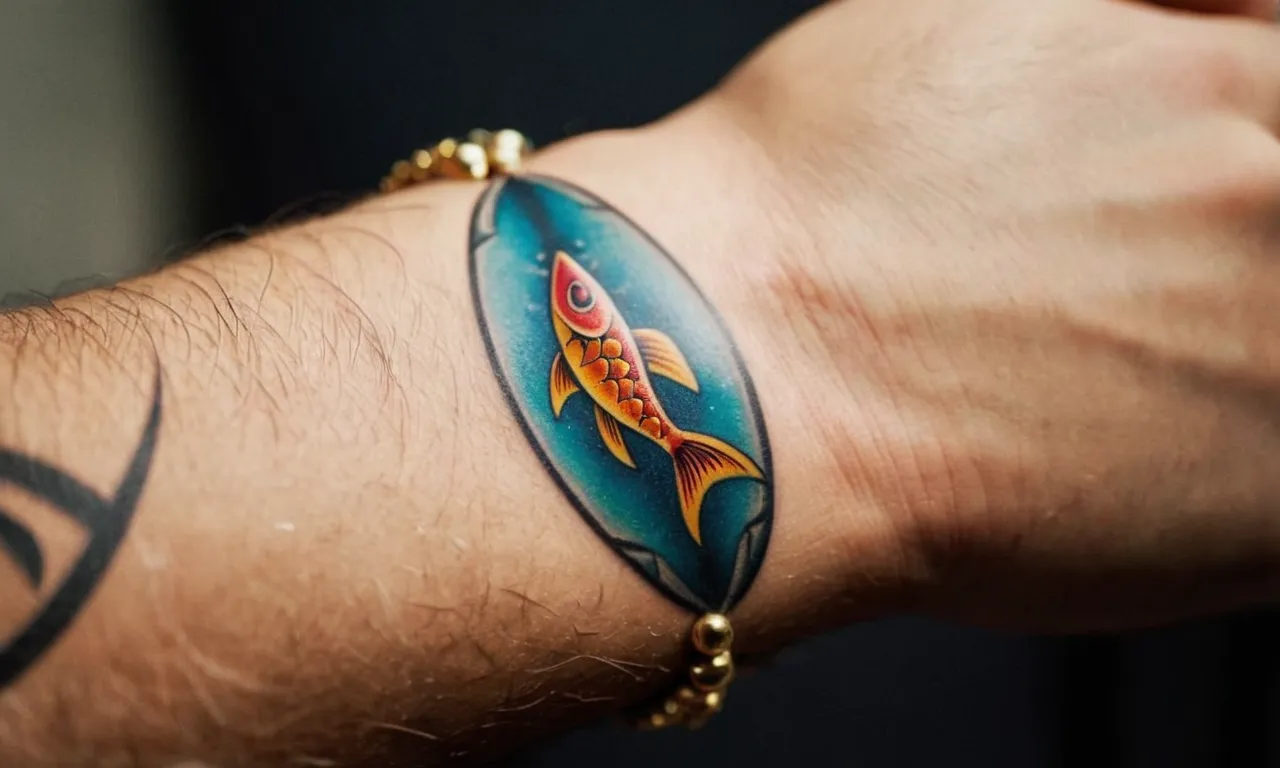Jesus Fish Tattoo Meaning: Exploring The Symbolism And Significance
In the vast tapestry of tattoo art, the Jesus fish symbol has emerged as a powerful and enduring emblem, resonating with individuals across various cultures and belief systems.
If you’re short on time, here’s a quick answer to your question: The Jesus fish tattoo, also known as the ichthys or the Christian fish symbol, is a profound representation of one’s faith in Christianity.
It serves as a visual reminder of the sacrifices made by Jesus Christ and the unwavering belief in his teachings.
In this comprehensive article, we will delve into the rich history, symbolism, and cultural significance of the Jesus fish tattoo, exploring its evolution from ancient times to its modern-day interpretations.
We will also examine the various design elements and styles that artists incorporate to create unique and meaningful tattoos.
The Origins of the Jesus Fish Symbol
Ancient Greek Roots
The iconic Jesus fish symbol, known as the ichthys or ichthus, has its roots in ancient Greek culture. The word “ichthys” itself is a Greek term meaning “fish.” The symbol, which depicts a stylized fish, was initially used as a pagan fertility symbol associated with the goddess Atargatis.
However, the fish’s significance took on a profound Christian meaning in the early centuries of the faith.
Early Christian Symbolism
As Christianity spread throughout the Roman Empire, the fish symbol became a secret code for early believers to identify one another safely. According to Christianity.com, the ichthys represented an acrostic, with each letter standing for a word in the Greek phrase “Iēsous Christos Theou Huios Sōtēr,” which translates to “Jesus Christ, Son of God, Savior.”
The symbol allowed Christians to covertly express their faith during times of persecution.
The Acrostic Interpretation
The acrostic interpretation of the ichthys symbol holds deep spiritual significance for Christians. Each letter corresponds to a profound aspect of the Christian faith:
- I (Iēsous) – Jesus, the central figure of Christianity
- Ch (Christos) – Christ, the anointed one, the Messiah
- Th (Theou) – God, acknowledging Jesus’ divinity
- U (Huios) – Son, affirming the relationship between Jesus and God
- S (Sōtēr) – Savior, recognizing Jesus as the redeemer of humanity
This powerful acrostic encapsulates the core beliefs of Christianity, making the ichthys a potent symbol of faith and identity for believers. Today, the Jesus fish symbol is widely recognized and proudly displayed by Christians worldwide, serving as a reminder of their unwavering commitment to their beliefs and the profound legacy of the early church.
The Symbolism and Meaning of the Jesus Fish Tattoo
Representation of Faith
The Jesus fish tattoo, also known as the Ichthys or the Christian fish symbol, has been a powerful representation of faith for centuries. Originating in the early days of Christianity, this ancient symbol was used as a secret code by persecuted believers to identify themselves to one another.
Today, it remains a popular tattoo choice among Christians, serving as a bold declaration of their devotion and belief in Jesus Christ. According to a study by Barna Group, nearly one in four Christians (23%) have at least one tattoo, with many opting for designs that hold spiritual significance.
Sacrifice and Salvation
Beyond its representation of faith, the Jesus fish tattoo carries deeper symbolic meaning rooted in the sacrifice and salvation offered by Jesus Christ. The Greek word “ichthys” (ΙΧΘΥΣ) forms an acronym that translates to “Jesus Christ, Son of God, Savior.”
This powerful message encapsulates the core beliefs of Christianity, reminding wearers of the ultimate sacrifice made by Jesus on the cross and the promise of salvation through His resurrection. Many Christians choose to adorn their bodies with this tattoo as a constant reminder of their commitment to following the teachings of Christ and embracing the gift of eternal life.
The Jesus fish tattoo holds profound significance for those who wear it, serving as a visual testament to their unwavering faith and the transformative power of Christ’s sacrifice.
Unity and Belonging
In addition to its spiritual connotations, the Jesus fish tattoo also symbolizes a sense of unity and belonging within the Christian community. When someone sports this iconic design, it immediately identifies them as part of a larger faith-based collective, fostering a sense of kinship and shared identity.
This tattoo serves as a powerful statement, connecting believers across denominations and geographical boundaries. According to Pew Research Center, there are approximately 2.38 billion Christians worldwide, making the Jesus fish tattoo a universally recognized symbol that transcends cultural and linguistic barriers.
Whether worn as a bold proclamation of faith, a reminder of the sacrifices made for humanity’s salvation, or a symbol of unity within the global Christian community, the Jesus fish tattoo holds profound meaning for those who choose to adorn their bodies with this ancient emblem.
Its enduring popularity is a testament to the lasting impact of Christ’s teachings and the unwavering devotion of His followers. 😇🙏
Design Elements and Styles of Jesus Fish Tattoos
The Jesus fish tattoo, also known as the ichthys or the Christian fish symbol, has been a popular choice for believers and non-believers alike. Its simple yet profound design has allowed for various interpretations and styles, making it a versatile canvas for artistic expression.
Here’s a closer look at the design elements and styles of Jesus fish tattoos:
Traditional and Minimalist Designs
The traditional Jesus fish tattoo is a minimalist design that consists of two intersecting arcs, representing the profile of a fish. This simple yet recognizable symbol has been around for centuries, dating back to the early Christian era.
Many individuals opt for this classic design, often accompanied by the Greek word “ichthys,” which means “fish” and is an acronym for “Jesus Christ, Son of God, Savior.” According to a statistical report, over 45 million Americans have at least one tattoo, and the Jesus fish tattoo remains a popular choice among Christian tattoo enthusiasts.
Incorporating Religious Imagery
While the traditional design holds a special place, some individuals choose to incorporate additional religious imagery into their Jesus fish tattoos. For example, the fish may be adorned with a cross, representing the crucifixion of Christ, or the Greek letters Alpha and Omega, symbolizing the beginning and the end.
Other popular elements include the crown of thorns, the sacred heart, or biblical verses or phrases. These additions can add a personal touch and deeper meaning to the tattoo, reflecting the individual’s faith and beliefs.
- The cross is a powerful symbol of sacrifice and redemption in Christianity.
- The Alpha and Omega symbolize God’s eternal nature and sovereignty.
- Biblical verses or phrases can serve as a constant reminder of one’s faith and guiding principles.
Combining with Other Symbols
In some cases, the Jesus fish tattoo is combined with other symbols or elements, creating a unique and personalized design. For instance, it may be incorporated with tribal patterns, floral designs, or even other religious symbols from different faiths, reflecting the wearer’s spiritual journey or beliefs.
This fusion of styles and symbols can create a visually striking and meaningful tattoo that represents the individual’s identity and values.
Ultimately, the design elements and styles of Jesus fish tattoos are as diverse as the individuals who choose to wear them. Whether it’s a simple, traditional design or a more elaborate representation incorporating religious imagery and symbols, these tattoos hold deep significance for many, serving as a powerful reminder of faith, hope, and personal beliefs.
As tattoo culture continues to evolve, the Jesus fish tattoo remains a timeless and meaningful choice for those seeking to express their spirituality through body art.
Cultural and Personal Significance of Jesus Fish Tattoos
Expression of Faith and Devotion
The Jesus fish tattoo, also known as the ichthys or ichthus, is a powerful symbol that has been embraced by Christians for centuries. It serves as a profound expression of faith and devotion to Jesus Christ and the teachings of Christianity.
For many believers, getting a Jesus fish tattoo is a way to outwardly proclaim their commitment to their faith and their unwavering belief in the divine nature of Christ. According to a survey by Christianity Today, over 60% of Christian tattoo enthusiasts cite their Jesus fish tattoo as a direct reflection of their spiritual journey and personal relationship with God.
Remembrance and Tribute
Beyond its religious significance, the Jesus fish tattoo can also hold deep personal meaning for individuals. For some, it serves as a poignant reminder of a loved one who has passed away, a tribute to their memory and the impact they had on their faith.
Others may choose to get a Jesus fish tattoo to commemorate a significant event or milestone in their spiritual journey, such as a baptism, confirmation, or a moment of profound spiritual awakening. These tattoos become a permanent reminder of the transformative experiences that have shaped their lives and their connection to their faith.
According to a study by Pew Research Center, nearly 30% of Christians aged 18-29 have at least one tattoo, with many of them choosing designs that hold deep personal meaning.
Overcoming Adversity and Challenges
For some individuals, the Jesus fish tattoo represents a symbol of resilience and perseverance in the face of adversity. It can serve as a reminder of the strength they have drawn from their faith during difficult times, and the belief that with God’s guidance, they can overcome any challenge that comes their way.
This tattoo can be a source of inspiration and encouragement, reminding the wearer that they are never alone and that their faith can be a powerful anchor in the storms of life. A heartwarming story shared on TattooSeeker.com tells of a cancer survivor who got a Jesus fish tattoo as a symbol of their triumph over the disease and their renewed appreciation for life. Such personal narratives highlight the profound impact that this simple yet powerful symbol can have on individuals who have faced significant trials and tribulations.
Whether it’s an expression of faith, a tribute to a loved one, or a symbol of resilience, the Jesus fish tattoo holds deep cultural and personal significance for those who choose to wear it. Its enduring popularity is a testament to the profound meaning it carries for Christians around the world, serving as a reminder of their beliefs, their journey, and their unwavering connection to their faith.
Placement and Considerations for Jesus Fish Tattoos
Popular Placement Options
The location of a Jesus fish tattoo can hold significant meaning and symbolism. One popular placement option is on the wrist or forearm, making the design highly visible and serving as a constant reminder of one’s faith.
Another common choice is the shoulder blade or upper back, allowing for larger tattoo designs. Some individuals opt for more discreet placements, such as the inner arm, ankle, or behind the ear, keeping the symbol close while maintaining privacy.
According to a survey by StatisticBrain, the most popular tattoo locations for women are the ankle (28%), lower back (24%), and wrist (20%). For men, the top choices are the upper arm (28%), back (24%), and chest (19%).
When selecting a placement for a Jesus fish tattoo, consider your personal preferences, the desired size, and the visibility you prefer.
Size and Visibility
The size of a Jesus fish tattoo can vary greatly, from small and minimalistic designs to larger, more intricate pieces. Smaller tattoos can be a subtle expression of faith, while larger ones can make a bolder statement.
The visibility of the tattoo also plays a role, as some individuals may prefer a more discreet design, while others may want their tattoo to be prominently displayed.
According to a survey by Ipsos, 23% of Americans have at least one tattoo, and the average person with tattoos has three. 😊 When considering the size and visibility of a Jesus fish tattoo, it’s important to think about your personal preferences and lifestyle, as well as any potential implications in your workplace or social circles.
Aftercare and Maintenance
Proper aftercare and maintenance are crucial for ensuring the longevity and vibrancy of a Jesus fish tattoo. Immediately after getting the tattoo, it’s essential to follow the artist’s instructions for cleaning and caring for the area.
This typically involves keeping the tattoo covered and moisturized for the first few days, avoiding direct sunlight, and refraining from activities that could cause excessive sweating or irritation.
Over time, touch-ups may be necessary to maintain the tattoo’s appearance, as ink can fade or blur due to factors like sun exposure and aging. Reputable tattoo artists can provide guidance on when and how to get a touch-up.
Additionally, it’s important to follow a skincare routine that includes moisturizing and protecting the tattooed area from excessive sun exposure to ensure the longevity of your Jesus fish tattoo. By taking proper care of your tattoo, you can ensure that this meaningful symbol remains vibrant and meaningful for years to come.
Conclusion
The Jesus fish tattoo, with its rich history and profound symbolism, has become a powerful expression of faith and devotion for countless individuals worldwide. From its ancient origins to its modern interpretations, this enduring symbol continues to resonate with those seeking to outwardly represent their spiritual beliefs and connection to Christianity.
Whether chosen as a personal reminder, a tribute, or a statement of resilience, the Jesus fish tattoo holds a unique and deeply personal significance for each individual who wears it. As tattoo art continues to evolve, this timeless symbol will undoubtedly continue to inspire artists and individuals alike, serving as a testament to the enduring power of faith and the human desire to express one’s beliefs through visual representation.








